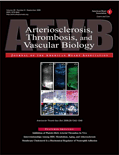Arteriosclerosis, Thrombosis, and Vascular Biology
Arteriosclerosis, Thrombosis, and Vascular Biology (ATVB) is a peer-reviewed medical journal that focuses on the study of the biology and pathophysiology of arteriosclerosis, thrombosis, and vascular biology. It is published by the American Heart Association and serves as a critical resource for researchers and clinicians in the field of cardiovascular medicine.
Scope and Focus[edit | edit source]
ATVB covers a wide range of topics related to the cardiovascular system, including the mechanisms of arteriosclerosis, the formation and resolution of thrombi, and the complex biology of blood vessels. The journal aims to provide insights into the molecular, cellular, and physiological processes that underlie cardiovascular diseases.
Arteriosclerosis[edit | edit source]
Arteriosclerosis refers to the thickening and hardening of the arterial walls, which can lead to atherosclerosis, a specific form of arteriosclerosis characterized by the buildup of plaque within the arterial walls. This condition is a major contributor to cardiovascular disease and can result in myocardial infarction and stroke.
Thrombosis[edit | edit source]
Thrombosis is the formation of a blood clot within a blood vessel, which can obstruct blood flow and lead to serious complications such as deep vein thrombosis and pulmonary embolism. Understanding the mechanisms of thrombosis is crucial for developing effective treatments and preventive strategies.
Vascular Biology[edit | edit source]
Vascular biology encompasses the study of the structure and function of blood vessels, including the endothelium, smooth muscle cells, and extracellular matrix. Research in this area is vital for understanding how blood vessels respond to injury, inflammation, and other pathological stimuli.
Editorial Policies[edit | edit source]
The journal adheres to rigorous peer-review standards to ensure the publication of high-quality research. It accepts original research articles, reviews, and editorials that contribute to the understanding of cardiovascular diseases.
History[edit | edit source]
ATVB was established to provide a dedicated platform for the dissemination of research in the fields of arteriosclerosis, thrombosis, and vascular biology. Over the years, it has become a leading journal in cardiovascular research, attracting contributions from prominent scientists and clinicians worldwide.
Impact and Influence[edit | edit source]
The journal has a significant impact on the field of cardiovascular research, influencing clinical practices and guiding future research directions. It is widely read by researchers, clinicians, and policymakers interested in the prevention and treatment of cardiovascular diseases.
Related Pages[edit | edit source]
Search WikiMD
Ad.Tired of being Overweight? Try W8MD's physician weight loss program.
Semaglutide (Ozempic / Wegovy and Tirzepatide (Mounjaro / Zepbound) available.
Advertise on WikiMD
|
WikiMD's Wellness Encyclopedia |
| Let Food Be Thy Medicine Medicine Thy Food - Hippocrates |
Translate this page: - East Asian
中文,
日本,
한국어,
South Asian
हिन्दी,
தமிழ்,
తెలుగు,
Urdu,
ಕನ್ನಡ,
Southeast Asian
Indonesian,
Vietnamese,
Thai,
မြန်မာဘာသာ,
বাংলা
European
español,
Deutsch,
français,
Greek,
português do Brasil,
polski,
română,
русский,
Nederlands,
norsk,
svenska,
suomi,
Italian
Middle Eastern & African
عربى,
Turkish,
Persian,
Hebrew,
Afrikaans,
isiZulu,
Kiswahili,
Other
Bulgarian,
Hungarian,
Czech,
Swedish,
മലയാളം,
मराठी,
ਪੰਜਾਬੀ,
ગુજરાતી,
Portuguese,
Ukrainian
Medical Disclaimer: WikiMD is not a substitute for professional medical advice. The information on WikiMD is provided as an information resource only, may be incorrect, outdated or misleading, and is not to be used or relied on for any diagnostic or treatment purposes. Please consult your health care provider before making any healthcare decisions or for guidance about a specific medical condition. WikiMD expressly disclaims responsibility, and shall have no liability, for any damages, loss, injury, or liability whatsoever suffered as a result of your reliance on the information contained in this site. By visiting this site you agree to the foregoing terms and conditions, which may from time to time be changed or supplemented by WikiMD. If you do not agree to the foregoing terms and conditions, you should not enter or use this site. See full disclaimer.
Credits:Most images are courtesy of Wikimedia commons, and templates, categories Wikipedia, licensed under CC BY SA or similar.
Contributors: Prab R. Tumpati, MD

